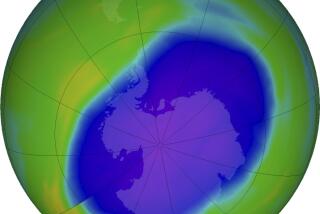UC Irvine Scientists Join Ozone Study : Research: A converted U-2 spy plane searches for evidence of damage to Earth’s protective shield.
- Share via
IRVINE — UC Irvine scientists are participating in an $8-million project, announced Monday by the National Atmospheric and Space Administration, which is studying the extent of damage to the protective ozone shield above the Arctic region.
Darin Toohey, a new assistant professor in UCI’s Geosciences department, began collecting air samples at high altitudes in the north polar region to determine what causes the type of hole in the ozone layer that has been found during late winter and early spring over the South Pole since the mid-1980s.
For the record:
12:00 a.m. Oct. 30, 1991 For the Record
Los Angeles Times Wednesday October 30, 1991 Orange County Edition Metro Part B Page 2 Column 4 Metro Desk 1 inches; 28 words Type of Material: Correction
NASA--The U.S. agency sponsoring an $8-million project for atmospheric research was incorrectly identified in an article Monday. The agency is the National Aeronautics and Space Administration.
The project, Airborne Arctic Stratospheric Expedition II, which was unveiled in Washington on Monday, involves a converted U-2 spy plane that measures a so-called “smoking gun” chemical, chlorine monoxide, found at high altitudes when ozone molecules are being destroyed. Toohey’s equipment aboard the single-seat aircraft, renamed the ER-2, began collecting high-altitude air samples on Oct. 7, the first of the project’s 30 missions.
Another aspect of the study involves low-altitude air samples collected aboard a NASA-owned DC-8 by researchers led by UCI chemist F. Sherwood Rowland. In 1973, Rowland, with a co-researcher, discovered that chlorofluorocarbons emitted by refrigerators, auto air conditioners, solvents and other sources had the power to deplete the Earth’s ozone layer, a shield about 10 to 15 miles high that screens out cancer-causing ultraviolet radiation.
Last week, a United Nations scientific panel found that ozone depletion was occurring all across the northern and southern hemispheres in the spring and summer months and at greater levels in the Arctic region than had been seen before.
“We need to understand much more about what’s going on in the Arctic and whether these same sorts of reactions can happen at lower altitudes,” said Nicola Blake, an atmospheric chemist from England who is working as a postdoctoral researcher in Rowland’s UCI laboratory.
“There is very little known about this whole branch of . . . chemistry. . . . And there is no substitute for actually measuring the air” at the site.
A member of Rowland’s team will be part of a group of 26 scientists who will leave from San Jose aboard the DC-8 in mid-November on the first of five monthly data-gathering flights, Blake and NASA officials said. The scientists will conduct 13 experiments and collect samples along a 10-hour route over the Arctic before landing in Stavanger, Norway, and making a return flight along a different path. Rowland’s team data will be returned to UCI for analysis.
Altogether, the studies will involve 120 scientists from NASA, the National Oceanic and Atmospheric Administration and five other universities.





